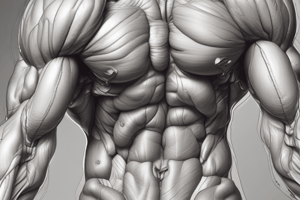Podcast
Questions and Answers
Explain the role of ATP in the contraction of a sarcomere.
Explain the role of ATP in the contraction of a sarcomere.
ATP provides the energy required for myosin to pull on actin filaments, allowing the sarcomere to contract.
Describe the function of myosin hooks during sarcomere contraction.
Describe the function of myosin hooks during sarcomere contraction.
Myosin hooks attach to actin binding sites and pull the actin filaments toward the center of the sarcomere, causing contraction.
What role does titin play in muscle contraction at the sarcomere level?
What role does titin play in muscle contraction at the sarcomere level?
Titin acts as a spring that maintains the structure of the sarcomere and prevents over-stretching during contraction.
How do the myofibrils contribute to sarcomere contraction?
How do the myofibrils contribute to sarcomere contraction?
What occurs at the actin binding sites during the contraction process?
What occurs at the actin binding sites during the contraction process?
Flashcards
Sarcomere
Sarcomere
The basic contractile unit of a muscle fiber. It's the repeating unit of myofibrils and contains the proteins that allow for muscle contraction.
Myosin Hooks
Myosin Hooks
Projections on the myosin filament that bind to actin binding sites, causing the thin filaments to slide past the thick filaments during contraction.
Actin Binding Sites
Actin Binding Sites
Locations on the actin filament where myosin hooks can attach and pull during contraction.
Titin
Titin
Signup and view all the flashcards
ATP's Role in Muscle Contraction
ATP's Role in Muscle Contraction
Signup and view all the flashcards
Study Notes
Sarcomere Contraction Mechanisms
-
A sarcomere is the fundamental unit of muscle contraction. It's the region between two Z-discs. The shortening of many sarcomeres in a myofibril leads to the overall shortening of the muscle fiber.
-
Myofibrils are bundles of protein filaments, primarily actin and myosin. These filaments are arranged in a highly organized structure within the sarcomere.
-
Actin filaments are thin filaments, and myosin filaments are thick filaments. The overlapping pattern of these filaments creates the striated appearance of muscle tissue.
The Sliding Filament Model
-
The sliding filament model describes how muscle contraction occurs. Myosin filaments "pull" actin filaments towards the center of the sarcomere, resulting in shortening of the sarcomere.
-
Myosin heads, the "hooks" projecting from the myosin filaments, bind to specific sites on the actin filaments. This binding is crucial for the contraction process.
The Role of ATP
-
Adenosine triphosphate (ATP) is essential for muscle contraction. It provides the energy needed for the myosin heads to detach from the actin binding sites and "re-cock" for another cycle of binding and pulling.
-
ATP binding to the myosin head causes a conformational change, detaching the myosin head from actin.
-
Hydrolysis of ATP into ADP and inorganic phosphate (Pi) then re-energizes the myosin head, moving it into a high-energy state/position, ready to bind to another actin-binding site.
The Power Stroke
-
The power stroke occurs when the myosin head releases the inorganic phosphate. This release triggers a conformational change in the myosin head, causing it to pull the actin filament inwards.
-
This "pulling" is a mechanical process, directly shortening the sarcomere. The myosin head is also releasing ADP in this process.
Actin Binding Sites and Myosin Hooks
-
Actin filaments possess specific binding sites for myosin heads. The myosin heads, or "hooks" can only bind to these sites if the muscle is stimulated.
-
The myosin heads bind to the actin binding sites in a "cross-bridge" formation, the critical first step in the contraction process.
Titin's Role
-
Titin is a large elastic protein that extends from the Z-disc to the M-line within the sarcomere.
-
Titin acts as a spring, providing elasticity and structural stability to the sarcomere.
-
It helps to prevent excessive stretching of the sarcomere during muscle contraction and return it to its normal shape after contraction.
-
Titin's elasticity helps to store elastic energy during muscle stretching (a process called passive elasticity (or mechanical stretch)), which helps to initiate the myosin pulling action for more efficient contraction.
-
Titin limits the range of movement to avoid overstretching or ripping/tearing of the muscle during movement.
Studying That Suits You
Use AI to generate personalized quizzes and flashcards to suit your learning preferences.
Description
Explore the fundamental unit of muscle contraction with this quiz on sarcomeres and the sliding filament model. Learn about the structure of myofibrils and the critical role of ATP in muscle contraction. Test your knowledge on how actin and myosin filaments work together to facilitate movement.




